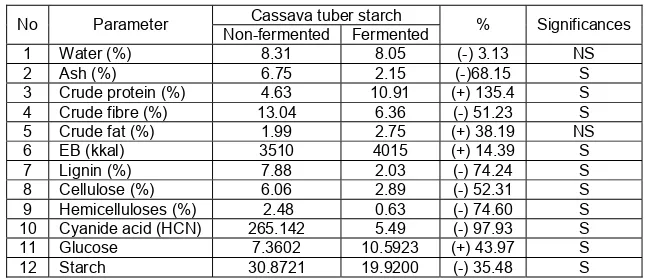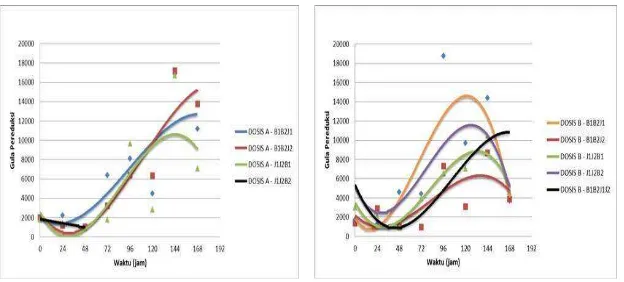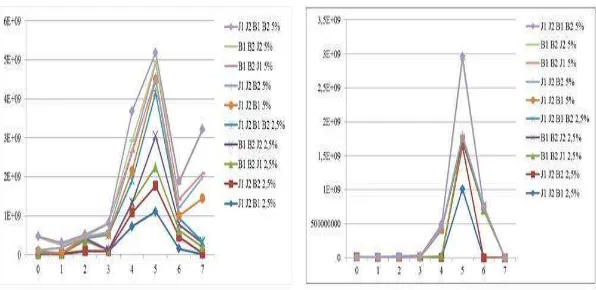THE QUALITY OF FERMENTED CASSAVA TUBER SKIN
AS HERBIVOROUS FISH FEED
Yuli Andriani
1*, Sukaya Sastrawibawa
1, Ratu Safitri
1, Abun Abun
11
University Padjadjaran, Bandung-Indonesian
Abstract
This research aims was to determine the quality improvement in the nutritional value of cassava
(Manihot esculenta Crantz) tuber skin waste through the fermentation process by cellulolytic
microbial consortium of Aspergillus tamari, Bacillus megaterium and Bacillus mycoides. The usefulness of this research is to improve the quality of the nutritional value of cassava tuber skin waste that can be used as herbivorous fish feed material. The research was conducted in the Laboratory of Microbiology, Department of Biology, Faculty of Mathematics and Natural Sciences, Universitas Padjadjaran. The experiment was conducted with experimental methods, while the data were analyzed using the T test. Fermentation was carried out for 7 days by the method of solid substrate. The parameters measured included 1) content of crude protein, crude fat, water, ash and energy using proximate analysis, 2) levels of cyanide acid (HCN) using AOAC method, 3) content of lignin, cellulose and hemicelluloses using van Soest analysis, and 4) content of glucose and starch using Luff Schoorls methods. The results showed that the enzymatic activity of microbial consortia of A. tamari, B. megaterium and B. mycoides in the fermentation process improved the quality of the nutritional value of cassava tuber skin. There was an increase in crude protein content, energy and glucose content from 4.63%, 3510 kkal and 7.36 ppm to 10.91%, 4015 kkal and 10.59 ppm at fermentation with 5% of microbial consortium. Meanwhile, the enzymatic process of the microbes decreased the content of crude fat, water, ash, HCN, starch, lignin, cellulose, and hemicelluloses.
The HCN content of cassava tuber skin waste significantly declined from 265.142 mg/kg to 5.49 mg/kg. This fermentation product in turn has a better biological value to be used as feed
materials for herbivorous fishes.
Key words: cassava tuber skin, fermentation, cellulolytic fungi and bacteria, nutrition value quality, herbivorous fishes
INTRODUCTION*
Cassava cultivation area in West Java reached 113,663 ha with total production reached up to 2,044,673 tons per year, while the skin to lose about 20% by weight of the wet bulb (Indonesian Central Bureau of Statistics, 2010). Potential cassava skin waste can be used as a source of carbohydrate-based feed materials in fish feed. The use of cassava tuber skins as a feed material faced with obstacles that are found in agricultural waste in general, i.e., low protein values (3.08 to 4.63%), carbohydrate that is in the form of crude fibre and its components such as lignin, cellulose and hemicelluloses which are form a complex bonds that is difficult to
*Corresponding author: yuliyusep@yahoo.com
The manuscript was received: 12.05.2012 Accepted for publication: 29.05.2012
digest by fish, and the amount of cyanide acid as a toxic material. Limitations in the use of crude fibre carbohydrates by fish are associated with the limited cellulolytic enzyme availability in the digestive tract of fish. Some studies reported that in the digestive tract of fish were found small amounts of cellulose activity [13, 3, 8,10].
were cellulolytic microbes that have high degradation ability of crude fibre. The microbial consortium of those microbes improved the quality of cassava tuber skin waste. Methods of SSF using a consortium of B. mycoides, B. megaterium, A. tamarii and P. nalgiovense at 5% showed an increment in the nutrition quality followed by a decrease in the cyanide acid content of cassava skin waste.
MATERIAL AND METHODS
The study was conducted by fermenting cassava tuber skin waste using 5% microbial consortium of Bacillus mycoides, Bacillus megaterium, Aspergillus tamarii and Penicillium nalgiovense. Fermentation was carried out by the SSF method for 7 days. At the end of the study, measurements were carried out on several quality parameters of nutritional value. Testing of crude protein, crude fat, water, ash and gross energy was done using proximate analysis; determination of lignin, cellulose and hemicelluloses was performed by the method of Van Soest; the measurement of glucose and starch content using the method of Luff Schoorls; and the test of cyanide acid content using the AOAC
method. Measurements on the same parameters were also conducted to the cassava skin without fermentation process as a control. The data were statistically tested with T test [5]. The results were an evaluation of the improvement of nutritional quality of fermented product using cellulolytic microbial consortium of A. tamarii, B. megaterium and B. mycoides.
RESULTS AND DISCUSSIONS
Fermentation of cassava tuber skin using a consortium of Aspergillus tamarii, Bacillus megaterium and Bacillus mycoides at the dose of 5% improved the quality of the nutritional value of cassava tuber skin waste, which was characterized by increased crude protein, glucose and gross energy (EB) contained in it. While the cyanide acid content, crude fibre, lignin, cellulose, hemicelluloses, ash and water were decreased. The T test results showed that all parameters were significantly changes, except for the increase in crude fat content and a decrease in water content values were not significant (Table 1).
Table 1 Significance parameter changes in fermented and non-fermented Cassava Tuber Skin
No Parameter Cassava tuber starch % Significances
Non-fermented Fermented
Degradation of crude fibre in the cassava skin caused by enzymatic properties of the microbes used in fermentation processes. Bacillus mycoides and B. megaterium were reported to have ability in producing amylase [15, 9]. The bacteria genus of Bacillus capable of degrading cellulose because it has cellulose enzymes characterized by the clear
capable of breaking the oligosaccharides into selobiosa, and β-glucosidase that breaks
down selobiosa into glucose.
, ,
,
,
Scheme 1. Crude fibre degradation by enzymatic of microbes
The cellulolytic ability of fungi A. tamarii and P. nalgiovense were higher compared with the bacteria B. mycoides and B. megaterium. This is in line with a statement saying that the fungi can produce celluloses include the genus of Trichoderma, Aspergillus and Penicillium [16]. Meanwhile, A. tamarii has cellulolytic capability better than P. nalgiovense. This is consistent with Ward et al. (2006) which states that the genus Aspergillus is a "factory" for the natural production of enzymes such as cellulose, xylanase, amylase, protease, and lipase, including alpha-amylase, glucoamylase, and hemiselulase. Four essential groups of enzymes that are commonly used in the biodegradation of cellulose, endoglukanase, selobiose, exoglucanases, and b-glucosidase, has been found in Aspergillus species [17]. The crude fibre degradation ability of the Aspergillus genus was reinforced by Dinata (2005) that indicated wheat bran fermentation using A. niger was able to lower crude fibre content of 11.17% to 9.51%.
One of the final products of crude fibre and starch decomposition in the fermentation process is in the form of glucose. Cellulose and amylase enzyme activities of the fungi is reflected in the measured reducing sugars during fermentation, which represents the amount of glucose formed as the final result by microbial degradation of crude fibre (Fig. 1). Decomposition of amylose by α-amylase occurrs in two phases. The first stage is the degradation of amylose into maltose and maltotriosa that occurs randomly. The degradation occurs very quick and followed by rapid decrease in viscosity. While the second phase is slower to form glucose and maltose as final results and is not random. Both are the action of the α-amylase enzyme on amylose molecules only. The action of α -amylase enzyme on amylopectin molecules will produce glucose, maltose, and various types of α-limit dextrin that is the oligosaccharide consisting of four or more sugar residues which all contain α-1, 6 binding [18]. Degradation causes intermittent starch to form dextrin with 6-10 glucose units along the chain.
Increased protein in the fermentation process associated with the growth of microbes in the substrate. Bacterial growing curve in the fermentation process showed the increment of the number of bacterial colonies at the beginning of the process, and the number of microbes decreased due to the death phase at the end of the experiment. This is consistent with the pattern of microbial growth [12], which generally microbes will experience a phase of death as carbon source in the substrate depleted and toxic metabolites increased. This condition is one factor in the increase of protein content in fermentation products, which occurs protein enrichment on the fermented
substrate derived from microbes (microbial protein).
Increased protein in the fermentation process is supported by systems that do fermentation, the fermentation medium is solid. Solid fermentation medium can be done as a process of enrichment of protein materials using certain microorganisms [1]. Protein enrichment process is similar to that of single cell protein production, but there is no separation of microbial cells from the substrate in the protein enrichment process. Protein increase in cassava tuber skin from 4.41% to the highest reach of 17.11% occurred at fermentation using 0.002% dose of Aspergillus niger [6].
Fig. 2. Growth Curve in Fermentation Using Bacteria and Fungi Consortium at Doses of 2.5% and 5%.
Cyanide acid (HCN) is the result of linamarin breakdown by the α-glucosidase enzyme and hidroksinitriliase thus formed sianihidrin then cyanide acid. Decreased levels of HCN in fermented cassava tuber skin caused by the enzymatic activity of the microbes used. Decreased levels of HCN is due to the termination of hexoses and HCN bonds by β-glucosidase enzyme produced by the activity of microorganisms during fermentation so that the hexose is no longer acting as a binder HCN [14].
CONCLUSIONS
Conclusion
The fermentation process using a microbial consortium of Aspergillus tamari, Bacillus megaterium and Bacillus mycoides
capable in improving the quality of the nutritional value of cassava tuber skin waste chemically. Indicators of quality improvement are characterized by increased protein and gross energy and declining limiting factors such as crude fibre, lignin, cellulose and hemicelluloses. Product criterion of fermented cassava tuber skin is eligible to be utilized as herbivorous fish feed.
Future Research Direction
Biological test by feeding trial methods is required to test a specific response to herbivorous fish.
ACKNOWLEDGEMENTS
this research through Postgraduate Grants Program 2008/2009 and Mr. Muhammad Ismail, who has involved in this current research.
REFERENCES
[1] Aisjah, T. 1995. Biokonversi Limbah Umbi Singkong Menjadi Bahan Pakan Sumber Protein
Oleh Jamur Rhizopus sp. Serta Pengaruhnya
Terhadap Pertumbuhan Ayam Pedaging.
Disertasi. Pascasarjana UNPAD. Bandung.
[2] Andriani, Y. 2010. Potential Exploration of Cellulolytic Microorganisms of Cow Rumen Fluid as a Source of Crude Fibre Biodegradation Agents in Agricultural Waste-Based Fish Feed Materials. Research Report, Universitas Padjadjaran, Bandung. Unpublished. [Translation]
[3] Bairagi A, Sarkar Ghosh K, Sen SK and Ray AK. 2004. Evaluation of the nutritive value of
Leucaena leucophala leaf meal, inoculated with
intestinal bacteria Bacillus subtilus and Bacillus
circulans in formulated diet for rohu, Lobeo rohita
(Hamilton) fingerlings. Aquaculture Research 35: 436-446.
[4] Donovan P, German and Rosalie AB. 2009. Digestive enzymes activity and gastrointestinal fermentation in wood-eating catfishes.
Comparative Physiology, 179(8):1025-1042.
[5] Gomez,K.A dan A.A Gomez. 1995. Prosedur
Statistik Untuk Penelitian Pertanian. Penerbit
UI-Press. Jakarta
[6] Gushairiyanto. 2004. Detoksifikasi dan
Fermentasi Kulit Umbi Ketela Pohon dengan Kapang Aspergillus niger Serta Implikasinya
Terhadap Performan Kambing Kacang Jantan.
Disertasi. Program Pascasarjana Universitas Padjadjaran Bandung. Tidak dipublikasikan. [7] Indonesian Central Bureau of Statistics. 2010. Crop Statistics. Jakarta, Indonesia.
[8] Lee, SM., Lee, JH. 2004 Effect of Dietary Glukose, Dextrin, and Starch on Grotwh and Body Composition of Juvenile Starry Flounder
(Platichthys stellatus). Fish. Sci 70 : 53-58.
[9] Liestianty, D. 2001. Penapisan dan Isolasi
Bacillus Penghasil Amilase Dari Limbah Sagu
(Metroxylon sagu Rottb). Ekologi Ternate 317-327
(2011)
[10] Nibedita, K and Koushik. 2008. Enzymes producing bacteria in the gastrointestinal tracts of
Labeo rohita (Hamilton) and Channa punctatus
(Bloch). Turkish Journal of Fisheries and Aquatic Sciences, 8:115-120
[11] Oyeleke, S. B. and Okusanmi, T. A. 2008. Isolation and Characterization of Cellulose Hydrolyzing Microorganism from The Rumen of Ruminants. African Journal of Biotechnology. Vol.
7 (10), pp. 1503-1504.
http://www.academicjournals.org/AJB/PDF/pdf20 08/16May/Oyeleke%20and%20Okusanmi.pdf (09/12/09)
[12] Pelczar, J.M. dan E.C.S. Chan. 1986.
Dasar-dasar Mikrobiologi I. Penerbit Universitas
Indonesia. Jakarta.
[13] Prejs, A and Blaszczyk M. 2006. Relationships between food and cellulas activity in freshwater fishes. Journal of Fish Biology. Vol 11;5;447-452
[14] Sumanti, D. 2010. Materi Teknologi
Fermentasi dalam Pelatihan Teknologi
Pengolahan Hasil Pertanian. Fakultas Teknologi
Industri Pertanian. Modul Kuliah. Universitas Padjadjaran. Bandung.
[15] Sintha. 1974. Kondisi Optimum bagi Produk Amilasa oleh Bacillus mycoides dan Aspergillus
oryzae. Skripsi. Institut Teknologi Bandung.
[16] Usama, A F., S. Hala. Saad El-Dein. 2008. Production and Partial Purification of Cellulase Complex by Aspergillus niger and A. nidulans
Grown on Water Hyacinth Blend. Journal of
Applied Sciences Research, 4 (7) : 875-891.
[17] Ward, O. P, W. M. Qin, J. Dhanjoon, J. Ye,
And A. Singh. 2006. Physiology And
Biotechnology Of Aspergillus. Department Of
Biology, University Of Waterloo, Waterloo, Ontario, Canada.


